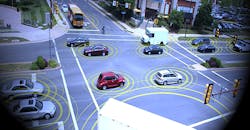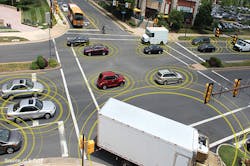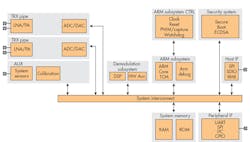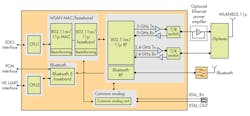Download this article in PDF format.
Most like a good scuffle, whether it takes the form of combat sports—“Everyone loves a fight," says Ultimate Fighting Championship (UFC) president Dana White, "it's in our DNA.”—or two technology camps vying to become an industry (or de facto) standard. A good example of the latter is the ongoing tiff between Wi-Fi-based 802.11p and cellular’s C-V2X technology, as they vie to represent vehicle-to-everything (V2X) communications on a global basis.
Currently, two key sets of standards for V2X communication exist, namely dedicated short-range communications (DSRC) in the U.S. and the Cooperative Intelligent Transport (C-ITS) standards in Europe. DSRC is a U.S. Department of Transportation (DoT) project based on the Communications Access for Land Mobiles (CALM) architecture for vehicle-based communication networks. On December 17, 2003, the FCC adopted a Report and Order establishing licensing and service rules for the DSRC Service in the Intelligent Transportation Systems (ITS) Radio Service occupying the 5.850- to 5.925-GHz band (5.9-GHz band).
What Exactly is DSRC?
The ultimate vision of DSRC is a nationwide network that enables communications between vehicles and roadside access points or other vehicles (Fig. 1). DSRC utilizes IEEE 802.11p, an approved amendment to the IEEE 802.11 standard, to add wireless access in vehicular environments (WAVE). It permits low-latency (2-ms) communication of basic safety messages between vehicles and between vehicles and roadside infrastructure.
1. Connected vehicles can improve safety at busy intersections. (Source: DoT)
The 802.11p standard also defines a way to exchange data through that link without the need to establish a basic service set (BSS), and in this way, without the need to wait for the association and authentication procedures to complete before exchanging data. The IEEE 802.11p equivalent in Europe’s C-ITS stack covering PHY and MAC is termed ITS-G5; like DSRC, it also operates in the 5.9-GHz band. In Japan, the DSRC equivalent operates in the 5.8-GHz spectrum.
DSRC uses orthogonal frequency-division multiplexing (OFDM), a widely used multi-carrier transmission scheme, and relies on the widely deployed WLAN standard defined in IEEE 802.11, specifying the physical transmission (PHY) and medium access control (MAC).
Security is defined in the IEEE 1609.2 standard, and provides authentication and optional encryption of DSRC messages based on digital signatures and certificates. To protect the privacy of drivers, certificates don’t contain information about the driver. What’s more, a vehicle uses a certificate only for a limited time, changing it frequently to make tracking more difficult.
IEEE 802.11p/DSRC offers the possibility for vehicle-to-infrastructure (V2I) and vehicle-to-pedestrian (V2P) connectivity. This gives the vehicle added situational awareness beyond what’s provided by advances in radar, LIDAR (light detection and ranging), and camera systems—these sensors are limited by their line of sight. V2X communication complements the capabilities of these sensors by delivering 360-degree non-line-of-sight awareness, extending a vehicle’s ability to “see” further down the road even in bad weather conditions.
What Exactly is C-V2X?
A challenger to DSRC for V2X has emerged from the cellular industry. Called C-V2X, it’s designed to complement and extend existing cellular capabilities. Like 802.11p, C-V2X direct communications support active safety and enhance situational awareness by detecting and exchanging information using low-latency transmission in the 5.9-GHz ITS band for vehicle-to-vehicle (V2V) as well as V2I and V2P scenarios. C-V2X can function without network assistance and has a range that exceeds one mile, even in areas where mobile network connections aren’t available.
C-V2X can combine the capabilities of roadside units (RSUs) and the cellular network to help improve safety and support autonomous driving. RSUs are radio base stations installed at intersections or along the side of the road (they can be on lamp poles, traffic light poles, and electronic toll collectors) that allow communications between vehicles (V2I or I2V) within a localized area. The roadside units will use a high-throughput connection with other cars on the road to build local, dynamic HD maps using camera and sensor data, and distribute them as needed.
Proponents of C-V2X argue that its biggest advantages are:
- The ability to use all features provided by the existing cellular LTE network.
- The ability to connect the car to all types of objects that either have sensors or cellular connectivity (including people via their smartphones).
- Improvements over 802.11p such as better alert latency and 2X the range.
- 5G-based C-V2X will be a key step toward autonomous cars, supporters claim, because it can help cars detect obstructions that aren’t visible to the driver.
- Since C-V2X can offer both device-to-device (V2V, V2I, and V2P) and device-to-network (V2N) services, it’s better suited to new and connected transportation systems around the globe.
C-V2X Release 15 (Rel-15), targeted for completion in September 2018, will augment the current Rel-14 by incorporating 5G NR (New Radio) features; providing higher-throughput, wideband carrier support for sensor data from surround cameras, radar, LIDAR, and other car sensors; enabling map sharing among vehicles; or even streaming video from one car to another. Rel 15 will maintain backward-compatibility with previous C-V2X releases.
C-V2X Developments
As reported earlier, less than a month ago Qualcomm introduced its first C-V2X commercial solution based on 3rd Generation Partnership Project (3GPP) Release 14 specifications for PC5-based direct communications. In addition, Qualcomm, which also supports DSRC and offers second-generation 802.11p DSRC chips, unveiled a C-V2X Reference Design that will feature the 9150 C-V2X chipset, expected to sample in commercial quantities in the second half of 2018. Field trials utilizing a pre-commercial form of the 9150 are currently taking place in Germany (with Audi) and France (with Peugeot).
Much hue and cry is being dispensed by C-V2X supporters out of fear that regulators may lock them out of the autonomous car sweepstakes. In comments to the NHTSA, which is considering a proposal that would require V2V communication to use DSRC devices, Qualcomm said: “We believe there should be an objective evaluation based on realistic deployment models that assess variations of a mandate and market penetration of 4G LTE and 5G devices that include C-V2X capabilities.”
Last week, Continental announced it will accelerate initiatives based on C-V2X technologies and conduct C-V2X field trials in select regions across the globe utilizing the Qualcomm C-V2X Reference Design with the integrated Qualcomm 9150 C-V2X chipset. Continental will build connected-car systems for field trials focused on demonstrating the capabilities of V2V, V2I, and V2P direct communication, as well as vehicle-to-network (V2N) wide-area communications to serve next-generation connected-car and automated-driving use cases.
2. C-V2X uses wireless connectivity to enable connected vehicles to achieve “Cooperative Awareness” for the realization of the “Basic Set of ITS Applications” as defined by ETSI, the European Telecommunications Standards Institute. (Source: Hong Kong telecommunications service provider PCCW-HKT)
The field trials will serve as an opportunity not only to showcase the benefits of C-V2X technologies, as defined by 3GPP Release 14 PC5 specifications, but also to demonstrate C-V2X range, reliability, traffic density, and latency for V2X communications.
As a result of these and other C-V2X developments, GSMA, which represents the interests of mobile operators worldwide, has urged the European Commission to keep the European market unrestricted for cellular technologies for use in connected vehicles (Fig. 2). In a position paper entitled “Safe and Smarter Driving: the Rollout of Cellular V2X Services in Europe,” GSMA has pressed the Commission to adopt a technology-neutral approach in developing the EU’s C-ITS, and calls upon European legislators to allow the market to decide which technology prevails.
GSMA points out that by year’s end, an estimated 23 million cars in Europe will be equipped with an LTE (4G) chipset for infotainment and emergency services. That number is expected to rise to 258 million cars by 2025 –virtually all new cars driving in Europe at that time.
802.11p: Counterpunching with New Hardware
While the C-V2X group is marshalling its forces, DSRC supporters have not been sitting idly by. Recently, the engineering troops working for 802.11p advocates have launched—ta-da!—new products that perform the way the technical pundits predicted a decade ago. Here are some examples:
NXP’s RoadLINK SAF5400 is an automotive-qualified, single-chip DSRC modem for V2X applications (Fig. 3). According to the supplier, it’s able to relay up to 2000 Basic Safety Message (BSM) verifications per second on chip. This number can be augmented further with NXP’s i.MX applications processor, which is based on 32- and 64-bit Arm technology developed initially by Freescale (acquired by NXP in 2015). V2X security requirements can also be met with software functions on i.MX processors,
3. The SAF5400 single-chip modem for V2Xm developed by NXP, can relay up to 2000 Basic Safety Message (BSM) verifications per second on chip. (Source: NXP)
The NXP SAF5400 modem integrates transceiver technology plus a full baseband, MAC, and firmware into a complete one-chip standalone modem. For security, NXP provides the SXF1800, offering resistance to physical probing and tampering. This dedicated hardware-secure element is said by NXP to be based on technology used today in many of the world's most sensitive security environments, such as electronic passports, banking cards, and smartphones (and now automobiles).
This V2X solution incorporates NXP's software-defined radio technology, which provides customers with a platform that supports different regional standards with a single hardware solution. The one-chip integration of analog RF with digital baseband processing into a single chip leverages NXP's RFCMOS technology for a smaller hardware footprint. This integration reduces development, qualification, and maintenance efforts, and eases the challenges of global V2X rollouts.
NXP says its platform meets and exceeds the current guidelines of the U.S. DoT's Notice of Proposed Rulemaking, as well as emerging standards in Europe, Japan, and Korea.
Speaking of Korea, LG Innotek introduced what it calls its “Second Generation” V2X Module for connected cars and autonomous vehicles. The core element that provides all of the communication functions combines three V2X core components into one product: the human-computer-interaction (HCI) module, a hardware security module (HSM) for controlling the communication protocol, and the application processor (AP). This integration saves automobile manufacturers from having to separately install different parts and undergo separate tests.
LG Innotek says the module can withstand temperatures up to 105°C and measures just 40 × 35 × 4, about one-third the size of a credit card. It has recorded a sensitivity level of −94 dBm as well as transmission power of 23 dBm for a device with a communication speed of 6 Mb/s. Even when the car is traveling at a high speed of 120 km/hr, transmitting and receiving are done without interruption from as far away as 1 km, claims the company.
4. Marvell's 88W8987xA offers Wi-Fi, Bluetooth 5, and 802.11p combination solutions for vehicle-to-everything (V2X) and in-vehicle infotainment (IVI). (Source: Marvell)
Marvell's88W8987xA is an automotive-grade system-on-chip (SoC) integrating the latest Wi-Fi, Bluetooth, V2V, and V2I capabilities (Fig. 4). The 88W8987xA family enables car manufacturers to simplify wireless enablement, and meets AEC-Q100 grade 2 standards, according to Marvell. The 88W8987xA family also supports Bluetooth 5, including Bluetooth Low Energy Angle of Arrival and Departure (AoA/AoD) and 802.11mc (802.11 MIMO-based collision resolution).
The family consists of three pin-to-pin compatible SoCs
- 88W8987A with 802.11ac and qualified Bluetooth 5 functionality
- 88W8987PA with 802.11p and qualified Bluetooth 5 functionality
- 88W8987SA with switchable 802.11ac/802.11p and qualified Bluetooth 5 functionality
The 88W8987xA is interoperable with a wide selection of host SoCs, hardware HSMs, WAVE (1609.x) stacks, and operating systems, and drivers are readily available for the Android platform, Linux, and QNX, according to Marvell.
So Who Will Win?
It’s difficult to say at this point, and not just because our record for forecasting market developments was never good enough to put Carnac the Magnificent out of business (those old enough to remember Carson’s Tonight Show will get this; the rest of you can check out the Wikipedia entry on The Tonight Show Starring Johnny Carson).
At the moment, 802.11p has the advantage, because the 5.9-GHz band made available in the U.S. more than a decade ago remains reserved for DSRC. Unless the C-V2X contingent, led by its chief trumpeter the 5G Automotive Association (5GAA), can convince government regulators that C-V2X offers a potentially technically superior and more flexible alternative, a DSRC mandate for 802.11p seems imminent.
In Europe, the EU plans to roll out System (C-ITS) in 2019. It, too, initially intended to make 802.11p the basis of the radio standard for safety-related messages between vehicles within the C-ITS framework called ITS-G5.
On the other hand, in China, the government appears ready to mandate C-V2X for C-ITS and safety-related services. Spectrum has already been put aside; 5905-5925 MHz was allocated for C-V2X trial projects in six major cities. This is an important development as the automotive industry generally wants to work with minimal standards differences worldwide, and the Chinese vehicle market will be the biggest in the world.
Here in the U.S., the legislation timeframe calls for a final rule on the subject to be made in 2019, followed by a phase-in period beginning in 2021, and compliance mandating V2V communication in all new light vehicles required by 2023.





